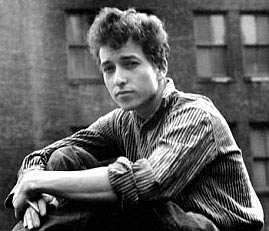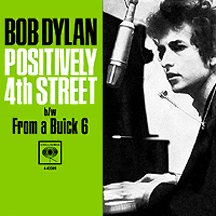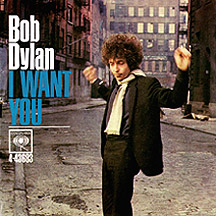BOB DYLAN
What could a kid like Robert Zimmerman do to pass the time growing up in Hibbing, Minnesota, waiting to turn 18 so he could leave the small town and avoid a hard life as a miner? Same thing I did growing up in Los Angeles - listen to the radio! There's one minor difference: having spent a fair amount of time in the midwest, I've experienced the pleasure of tuning in AM stations late at night from as far away as a thousand miles (something that was nearly impossible to do in L.A., except in the case of a few high-wattage stations located just over the Mexico border, beaming their transmitters straight at us). In a small midwest town, AM reception covers a wider radius after sunset, and listeners like young Robert, then as now, could expose themselves (though to a lesser degree these days thanks to corporate radio narrowmindedness) to a vast landscape of pop, country, rhythm and blues and, in the mid- to late-'50s, the first of those rock and roll-based top 40 stations that played one 45 after another. Bob Dylan appeared in Greenwich Village shortly after Zimmerman left Hibbing, musical influences and direction determined, his new name seeping into nearly every household...not at first, but after his label, Columbia, began releasing his music on 45s. 14 singles were released in the United States between 1962 and 1969, and of those, there are several variations.
"Mixed Up Confusion" came out of Dylan's first studio session with backing musicians (up to that point he recorded as a true solo, playing guitar and harmonica). A single-only release near the end of 1962, just one year after signing with the label as a folk act and about eight months after his self-titled debut album, he was already dipping his toes into rock waters and finding it uncomfortable, backing off and sticking with his primary approach for the time being. The flip side, an adaptation of the country/folk standard "Corrina Corrina," was included on the album The Freewheelin' Bob Dylan several months later.
Peter, Paul and Mary gave the mainstream audience its first taste of Dylan when their cover of "Blowin' in the Wind" became a major hit in the summer of 1963. They followed it with "Don't Think Twice, It's All Right" in the fall. Columbia released the Freewheelin' originals back-to-back as his second single at the exact same time as the trio's follow-up. I suspect the plan was to promote "Don't Think Twice" in an attempt to beat PP&M to the punch, but they were embedded in the public's consciousness by this time and scored their second Dylan-penned top ten hit in a row.
The label was releasing Dylan's singles at intervals of a year or more, either unconcerned about breaking him in the top 40 market, or possibly doubting he had any chance. The next single derailed any skepticism. "Subterranean Homesick Blues," complete with full studio band, was unleashed on the world with its stream-of-consciousness observations at the start of spring 1965, simultaneous with its accompanying album Bringing it All Back Home. He suddenly found himself in unfamiliar territory: the top 40. A black-and-white promotional film, shot in an alley behind London's Savoy Hotel had Bob holding up cue cards showing key phrases from the lyrics synced (nearly) to the song as it played. Featured in the D.A. Pennebaker documentary film about Dylan, Don't Look Back, its fame as one of the earliest rock music videos has grown to immeasurable proportions. The flip side, "She Belongs To Me," became a hit when Rick Nelson recorded it in 1969.
"Like a Rolling Stone" came next, big rock arrangements appearing to be the new modus operandi, and Bob Dylan had arrived as an unlikely, enigmatic superstar. The song ran more than 6 minutes (shown as 6:00 exactly on the label); early promo copies split it into two parts, and I can recall stations fading the song at the short harmonica break around the three minute mark. Once it became a hit in the summer of '65, indeed one of the year's biggest, it was played in its entirety from that point on. At least a few five minute singles had become hits over the years, but this was the first to run over six. The flip "Gates of Eden," at 5:48, gave buyers of the 45 good value for their money: just under 12 minutes of Dylan at his best.
"Positively 4th Street" was his fifth single and the first since "Mixed Up Confusion" not included on an album (that is, until the '67 Greatest Hits collection). Its scathing lyrics suggest he had a bone to pick with someone and chose to verbalize it in front of millions of onlookers. That sizeable crowd made the single his second top ten hit in a row. Its B-side, "From a Buick 6," was taken from the "Rolling Stone" LP Highway 61 Revisited. The title track of that album would be the B-side of the next single. Some pressings of "Positively" were puzzling; while labeled the same as regular copies, what was in the grooves was a version of "Can You Please Crawl Out Your Window?" from the Highway 61 sessions. Some years ago I picked up one of those singles, reacting with a "What th-?" when I heard it, afterward finding out it was a mistake and only a limited number had gotten out before they corrected it on subsequent pressings. The intended single version of "Crawl" (another non-LP 45), recorded with Ronnie Hawkins' backup band The Hawks, hit the charts at the start of 1966.
"One of Us Must Know (Sooner or Later)" was the lead single for the double-disc album Blonde on Blonde, while "Queen Jane Approximately" made it the third in a row with a Highway 61 Revisited flip side. The next single, the notorious 'everybody must get stoned' smash "Rainy Day Women #12 & 35" is an edit of the album version, cut down by two minutes. Unavailable that way on CD or in stereo, I set upon the task some years ago of doing the edit myself. Locating the song's one splice was hard enough (it's in the middle of the line 'they'll stone you...when you're at the breakfast table,' replacing the last part of the line a minute later with '...and say that it's the end,' which is the only way the sounds of the guys yelling in the background will sync with the single version), yet it still ran about ten seconds too long (the solution was to speed the song up slightly to get the correct length of 2:26...tricky!). The bluesy flip, "Pledging My Time," is a short version as well, although at 3:42 it shouldn't have been necessary to shorten the length at all, much less slash it to 2:06.

"I Want You" followed, one of his best and biggest, backed with his first live recording to appear on a single, "Just Like Tom Thumb's Blues," from a May 1966 concert in Liverpool, England. It was the last of a series of promo 45s (starting with "Subterranean") sent to radio stations on attention-grabbing red vinyl. Dylan's tenth single release was yet another edit of a longer Blonde album track (less perplexing than "Rainy Day Women" with one splice and a fade at the end): "Just Like a Woman" became his sixth top 40 hit in a span of just 18 months, and the practice of chopping down the songs, so contrary to the six minute success of "Stone" in '65, ended, at least for the remainder of the decade. Its flip was consistent with Bob's open-to-interpretation style of writing: the "Obviously 5 Believers" of the title have something to do with 15 jugglers, but just what that means I'll leave to others to ponder.
Seven months passed until the next 45 appeared in the spring of 1967, and it too was from Blonde on Blonde. Five singles! An unusual game plan for a guy who once recorded albums that didn't have even one. I like to think it was because "Leopard-Skin Pill-Box Hat" was just too cool to be passed over for airplay. With the flip, "Most Likely You Go Your Way and I'll Go Mine," eight of the album's fourteen tracks had appeared on 45s.
December 1967 saw the release of John Wesley Harding, and it still seems odd that an album with five singles would be followed by one with none. But so it appeared, and it resulted in a full two years between 45 releases, the 27-minute country music project Nashville Skyline supplying five of the next trio of singles' six sides. "I Threw it All Away" reached back to Harding for its B-side, "Drifter's Escape," nullifying the previous LP's designation as an all-album-cut collection.
Next up was "Lay Lady Lay," written for his wife Sarah, with obvious sexual overtones. Featuring steel guitar playing by Pete Drake (whose "talking guitar" recording of "Forever" was a hit in 1965), it became Bob's first top ten hit in over three years. The flip side, "Peggy Day," found him in a frisky mood with its playful 'love to spend the night with Peggy Day...love to spend the day with Peggy Night' lyrics. "Tonight I'll Be Staying Here With You" confirmed his preoccupation with romance at this time, but the flip side of that 14th and final '60s single alluded to another type of desire: to use a down-on-the-farm-style phrase, he really put the feed bag on with "Country Pie."
NOTABLE SINGLES:
- Mixed Up Confusion /
Corrina Corrina - 1962 - Blowin' in the Wind /
Don't Think Twice, It's All Right - 1963 - Subterranean Homesick Blues /
She Belongs To Me - 1965 - Like a Rolling Stone /
Gates of Eden - 1965 - Positively 4th Street /
From a Buick 6 - 1965 - Can You Please Crawl Out Your Window? /
Highway 61 Revisited - 1965 - One of Us Must Know (Sooner or Later) /
Queen Jane Approximately - 1966 - Rainy Day Women #12 & 35 /
Pledging My Time - 1966 - I Want You /
Just Like Tom Thumb's Blues - 1966 - Just Like a Woman /
Obviously 5 Believers - 1966 - Leopard-Skin Pill-Box Hat /
Most Likely You Go Your Way and I'll Go Mine - 1967 - I Threw it All Away /
Drifter's Escape - 1969 - Lay Lady Lay /
Peggy Day - 1969 - Tonight I'll Be Staying Here With You /
Country Pie - 1969



